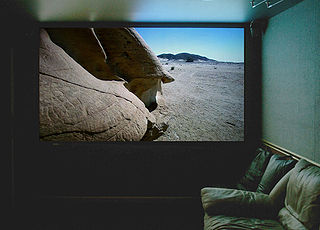
Holography is a technique that enables a wavefront to be recorded and later re-constructed. Holography is best known as a method of generating three-dimensional images, but it also has a wide range of other applications. In principle, it is possible to make a hologram for any type of wave.
Reginald Endicott Barclay III is a fictional engineer from the Star Trek media franchise. On television and in film, he has been portrayed by Dwight Schultz since the character's introduction in the Star Trek: The Next Generation third season episode "Hollow Pursuits". Schultz played the character for five episodes and one feature film of The Next Generation, as well as six episodes of the spin-off series Star Trek: Voyager. Barclay also appears in non-canon Star Trek novels and video games.

The Holodeck is a fictional device from the television franchise Star Trek which uses "holograms" to create a realistic 3D simulation of a real or imaginary setting, in which participants can freely interact with the environment as well as objects and characters, and sometimes a predefined narrative.
"The Cage" is the first pilot episode of the American television series Star Trek. It was completed on January 22, 1965. The episode was written by Gene Roddenberry and directed by Robert Butler. It was rejected by NBC in February 1965, and the network ordered another pilot episode, which became "Where No Man Has Gone Before". Much of the original footage from "The Cage" was later incorporated into the season 1 two-parter episode "The Menagerie" (1966). However, "The Cage" was first released to the public in VHS in 1986, with a special introduction by Gene Roddenberry, and was not broadcast on television in its complete form until 1988. The black and white version and shorter all-color version was also released in various standard-definition media of this period including LaserDisc, VHS, and DVD formats.
"Encounter at Farpoint" is the pilot episode and series premiere of the American science fiction television series Star Trek: The Next Generation, which premiered in syndication on September 28, 1987. It was written by D. C. Fontana and Gene Roddenberry and directed by Corey Allen. Roddenberry was the creator of Star Trek, and Fontana was a writer on the original series. It was originally aired as a two-hour TV movie, and subsequent reruns typically split the episode into two parts.

An LCD projector is a type of video projector for displaying video, images or computer data on a screen or other flat surface. It is a modern equivalent of the slide projector or overhead projector. To display images, LCD projectors typically send light from a metal-halide lamp through a prism or series of dichroic filters that separates light to three polysilicon panels – one each for the red, green and blue components of the video signal. As polarized light passes through the panels, individual pixels can be opened to allow light to pass or closed to block the light. The combination of open and closed pixels can produce a wide range of colors and shades in the projected image.

A video projector is an image projector that receives a video signal and projects the corresponding image on a projection screen using a lens system. Video projectors use a very bright Ultra-high-performance lamp, Xenon arc lamp, LED or solid state blue, RB, RGB or remote fiber optic RGB lasers to provide the illumination required to project the image, and most modern ones can correct any curves, blurriness, and other inconsistencies through manual settings. If a blue laser is used, a phosphor wheel is used to turn blue light into white light, which is also the case with white LEDs. A wheel is used in order to prolong the lifespan of the phosphor, as it is degraded by the heat generated by the laser diode. Remote fiber optic RGB laser racks can be placed far away from the projector, and several racks can be housed in a single, central room. Each projector can use up to two racks, and several monochrome lasers are mounted on each rack, the light of which is mixed and transmitted to the projector booth using optical fibers. Projectors using RB lasers use a blue laser with a phosphor wheel in conjunction with a conventional solid state red laser.
"Elementary, Dear Data" is the third episode of the second season of the American science fiction television series Star Trek: The Next Generation, the 29th episode overall. It was written by Brian Alan Lane and directed by Rob Bowman. It was originally released on December 5, 1988, in broadcast syndication.
"Ship in a Bottle" is the 138th episode of the American science fiction television series Star Trek: The Next Generation, the 12th episode of the sixth season.
"The Big Goodbye" is the twelfth episode of the American science fiction television series Star Trek: The Next Generation. The episode first aired in broadcast syndication on January 11, 1988. This was the second writing credit of the series for Tracy Tormé following the episode "Haven". Rob Bowman planned to direct the episode, but he was switched to "Datalore" due to delays in its production. With Bowman working on another episode, Joseph L. Scanlan became the director.
"Manhunt" is the nineteenth episode of the second season of the American science fiction television series Star Trek: The Next Generation, the 45th episode overall, originally broadcast on June 19, 1989.
"Projections" is the 19th episode of the American science fiction television program Star Trek: Voyager. Originally slated for the first season, the episode originally aired on UPN on September 11, 1995, and tells the story of Voyager's holographic doctor having an identity crisis on the holodeck regarding whether he or the world around him is the illusion.
"Bride of Chaotica!" is the 106th episode of the American science fiction television series Star Trek: Voyager airing on the UPN network, the 12th episode of the fifth season. The episode originally aired on January 27, 1999. The episode largely takes place on the holodeck, which is running a holo-program in black and white instead of the usual color. This was because of a small fire to the Bridge set that had occurred while the episode was in production; as a result the Bridge scenes were shot weeks later after the set was repaired and scenes that were originally set for the Bridge were either entirely rewritten or set on a different part of the ship. The episode satirizes numerous elements of the classic 1936 film serial Flash Gordon and classic 1939 film serial Buck Rogers.
"Real Life" is the 64th episode of Star Trek: Voyager and the 22nd episode of the third season. This episode revolves around the Doctor dealing with his holographic family program. Robert Picardo plays a holographic AI aboard the starship USS Voyager in the 24th century.
"Author, Author" is the 166th episode of the TV series Star Trek: Voyager, the 20th episode of the seventh season. This episode focuses on the character "The Doctor" (EMH) and on impact of a novel and explores the meaning of AI.
"The Killing Game" is a two-part episode of the science fiction television series Star Trek: Voyager, the 18th and 19th episodes of the fourth season. In the episode, a Hirogen hunting party has taken over Voyager and put its crew to work as living holodeck characters. Their minds are controlled by neural interfaces which make them believe they are their characters, and the Hirogen hunt them in two holodeck programs. These are the third and fourth episodes of the Hirogen story arc.
"Flesh and Blood" is a two-part episode from the seventh season of the science fiction television series Star Trek: Voyager. The crew of USS Voyager must contend with violent Delta Quadrant aliens the Hirogen, who use the holodeck technology with a horrific amoral twist.

The Star Trek Concordance is a reference book by Bjo Trimble about the television series Star Trek. The first edition was self-published in 1969. A mass-market edition was published in 1976. The 1976 edition contains summaries from every episode of The Original Series and The Animated Series, as well as an encyclopedia of characters and technology from the series. It was used as a reference for later writers of the show.
Holography is often used as a plot device in science fiction, appearing in a wide range of books, films, television series, animation and video games. Probably the first reference is by Isaac Asimov in his sci-fi novel series “the Foundation Trilogy” in 1951.
Solid light, often referred to in media as "hard light" or "hard-light", is a hypothetical material, made of light in a solidified state. It has been theorized that this could exist, and experiments claim to have created solid photonic matter or molecules by inducing strong interaction between photons. Potential applications of this could include logic gates for quantum computers, and room-temperature superconductor development.





